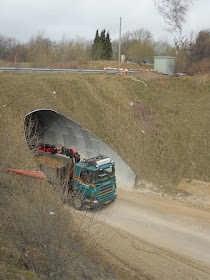Other companies continue to supply gravel in Denmark and several new areas has been opened for extraction, even though for environmental reasons permits are much harder to get. On the outskirts of greater Copenhagen a large gravel deposit has been exploited since the 1890´s. Originally the centre of the extraction was Hedehusene, but today the areas exploited have moved west and south. This week I took a bike ride through the area to see what modern gravel extraction looks like. Here are a few images of what I saw.
 |
| I would like to see this Volvo excavator with its arm fully extended! |
 |
| A view into the active part of the gravel area. Roskilde is in the horizon. |
 |
| Lorry with a load of gravel coming through the tunnel once used for a conveyor belt. |
 |
| Partly dismantled conveyor belt. Its role now taken over by lorries. |
 |
| Another loaded lorry leaves for a construction site. Old gravel pits as far as you can see. |
 |
| Traces of gravel workings not used for almost fifty years: Old and overgrown open topped gravel silos. |
 |
| 785 mm. tracks ran under the silo through this tunnel. Sleepers with spikes can still be found inside the tunnel. |
 |
| Inside the tunnel you can still see levers and the chutes used for loading skips. |
 |
| Not a part of the lifted Nystrup Gravel line, but the foundation for the expansion of a very living railway in the old gravel workings south of Hedehusene. In a few years Hedelands Veteranbane will be running steam trains here - the only place in Denmark where you'll have a view to vineyards from a train. |

No comments:
Post a Comment